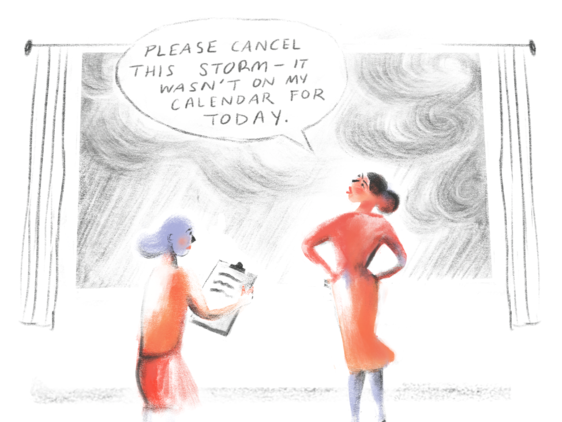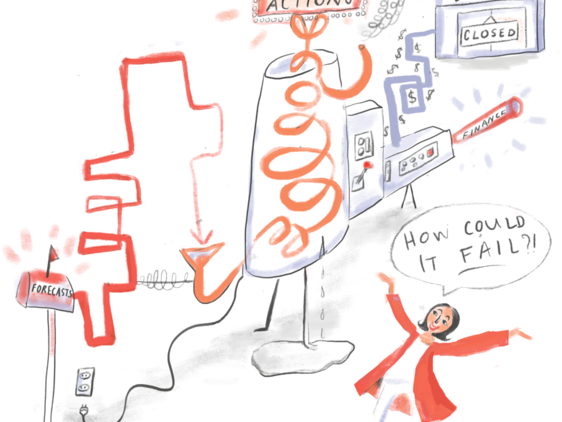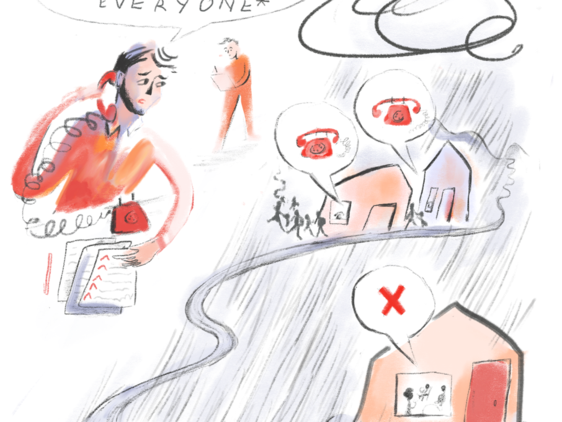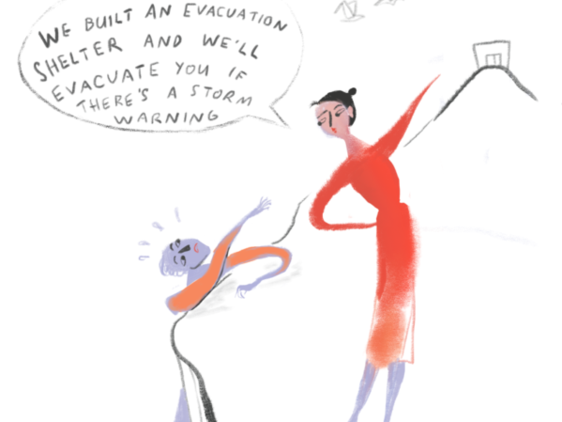Lessons Learnt
Find key lessons learned by the Anticipatory Community over the years of implementing Early Warning and Early Action projects from around the globe.
During recent years, the Anticipatory Action community of practice has built up a wealth of lessons ranging from the design, set up and activation of Anticipatory Action programmes, strategies, and policies. In this section you will find resources that can help you identify lessons at all different levels of the Anticipatory Action process.
What can go wrong with a Forecast-based Financing project?
Achieving great things
The goal of Forecast-based Financing is to reduce the impact of disasters.
In the window of time between a forecast and a hazard’s impact, FbF releases resources to take early action. Ultimately, we hope this early action will be more effective at reducing suffering, compared to waiting until the disaster happens and then responding. For example, in Bangladesh, people who received a forecast-based cash transfer were less malnourished during a flood in 2017.
With the promise of increased effectiveness, the concept of FbF is rapidly gaining traction in the humanitarian and development sectors. Clearly, FbF can be a useful tool to assist communities who would otherwise experience a catastrophe.
However…what could possibly go wrong?
FbF doesn’t inherently have a higher chance of “going wrong” than much of our other work. But because it is new, people might not realize potential pitfalls.
Here we outline several ways in which FbF can go wrong – some are inevitable, and some can be avoided.
Let’s create a fake country – let’s call it Madeupsville.
In Madeupsville, FbF has taken off, and is widely implemented by everyone. However, in Madeupsville, people are starting to run into a few problems…
Scroll through the images to learn more about Madeupsville's problems implementing FbF

ACT IN VAIN In Madeupsville, the disaster managers evacuated several villages based on a cyclone forecast, but, then the cyclone took a sharp turn, hit a different region. The people of Madupsville got really mad because they’d evacuated “in vain” and accused the mayor of squandering city funds. © Rebeka Ryvola / RCCC

UNFORCASTED The next year, Madeupsville was hit by a monster storm. The forecasts hadn’t warned of such a big event, and people were frustrated there was no early action taken. © Rebeka Ryvola / RCCC

TOO COMPLICATED Even though the meteorological service of Madeupsville developed a high-tech model with the most amaaaazing data, the system went offline and no one knew that a disaster was forecasted! Actions are not taken in time The FbF system triggered while the Madeupsville disaster manager was away. Logistics staff had only one vehicle and couldn’t get goods to the neighborhoods in time to help. Early action came too late! The money doesn’t arrive The next time they got the alert, Madeupsville Red Cross was ready to go! But, they had to wait 2 weeks for the fund transfer, and by that point the disaster had occurred. © Rebeka Ryvola / RCCC

ACTIONS ARE USELESS In Madeupsville, the local Red Cross gave people storage buckets to protect harvested food from a forecasted flood. However, because the buckets had no ventilation, all their food spoiled. © Rebeka Ryvola / RCCC

CONFLICT OF INTEREST In Madeupsville, the large-scale hay distributor talked to his friend at the weather service. His friend agreed to send a drought forecast to a local NGO, and voila! The hay distributor got lots of business that year. He made sure to share some of his earnings with his friend at the weather service! © Rebeka Ryvola / RCCC

SCALE Only a local project When a major storm is forecasted for the Eastern part of Madeupsville, no one is ready to take action because the pilot project is only in a few villages in the West. Actions are not right-sized When a flood trigger happens, the Madeupsville Red Cross distributes one week of water purification tablets to all households in the 3 pilot villages. However, for 4-6 weeks the families drink dirty water and are also exposed to contaminated food. This leads to a large-scale outbreak of diarrheal disease, and people wonder why FbF did not eliminate the disaster! © Rebeka Ryvola / RCCC

INEQUALITY The FbF team in Madeupsville is verrry proud of their data-driven FbF programme, which uses state-of-the-art vulnerability and exposure data to target people most affected by a forecasted disaster. However, the team does not realize that landless migrant populations are totally missing from this database. Therefore, no one evacuates the landless people during an FbF intervention. What’s worse, there was no coordination among agencies, and local NGOs targeted the same people. © Rebeka Ryvola / RCCC

WRONG PRIORITIES In Madeupsville, FbF became such a cool innovative idea that everyone and their brother starting making FbF projects! The Madeupsville government was excited to involve domestic tech and modelling firms. They even tried to fund FbF projects for disasters that were not forecastable! Less and less money and attention was paid to the incremental benefits of this investment for people, measuring success only from an international financial point of view. Also, community members complained about receiving lots of forecast-based hygiene kits when by far the leading cause of death was road accidents. They really wished someone had just given out motorcycle helmets, instead of using complicated forecasts to distribute soap every few years. © Rebeka Ryvola / RCCC

ACT IN VAIN In Madeupsville, the disaster managers evacuated several villages based on a cyclone forecast, but, then the cyclone took a sharp turn, hit a different region. The people of Madupsville got really mad because they’d evacuated “in vain” and accused the mayor of squandering city funds. © Rebeka Ryvola / RCCC
UNFORCASTED The next year, Madeupsville was hit by a monster storm. The forecasts hadn’t warned of such a big event, and people were frustrated there was no early action taken. © Rebeka Ryvola / RCCC
TOO COMPLICATED Even though the meteorological service of Madeupsville developed a high-tech model with the most amaaaazing data, the system went offline and no one knew that a disaster was forecasted! Actions are not taken in time The FbF system triggered while the Madeupsville disaster manager was away. Logistics staff had only one vehicle and couldn’t get goods to the neighborhoods in time to help. Early action came too late! The money doesn’t arrive The next time they got the alert, Madeupsville Red Cross was ready to go! But, they had to wait 2 weeks for the fund transfer, and by that point the disaster had occurred. © Rebeka Ryvola / RCCC
ACTIONS ARE USELESS In Madeupsville, the local Red Cross gave people storage buckets to protect harvested food from a forecasted flood. However, because the buckets had no ventilation, all their food spoiled. © Rebeka Ryvola / RCCC
CONFLICT OF INTEREST In Madeupsville, the large-scale hay distributor talked to his friend at the weather service. His friend agreed to send a drought forecast to a local NGO, and voila! The hay distributor got lots of business that year. He made sure to share some of his earnings with his friend at the weather service! © Rebeka Ryvola / RCCC
SCALE Only a local project When a major storm is forecasted for the Eastern part of Madeupsville, no one is ready to take action because the pilot project is only in a few villages in the West. Actions are not right-sized When a flood trigger happens, the Madeupsville Red Cross distributes one week of water purification tablets to all households in the 3 pilot villages. However, for 4-6 weeks the families drink dirty water and are also exposed to contaminated food. This leads to a large-scale outbreak of diarrheal disease, and people wonder why FbF did not eliminate the disaster! © Rebeka Ryvola / RCCC
INEQUALITY The FbF team in Madeupsville is verrry proud of their data-driven FbF programme, which uses state-of-the-art vulnerability and exposure data to target people most affected by a forecasted disaster. However, the team does not realize that landless migrant populations are totally missing from this database. Therefore, no one evacuates the landless people during an FbF intervention. What’s worse, there was no coordination among agencies, and local NGOs targeted the same people. © Rebeka Ryvola / RCCC
WRONG PRIORITIES In Madeupsville, FbF became such a cool innovative idea that everyone and their brother starting making FbF projects! The Madeupsville government was excited to involve domestic tech and modelling firms. They even tried to fund FbF projects for disasters that were not forecastable! Less and less money and attention was paid to the incremental benefits of this investment for people, measuring success only from an international financial point of view. Also, community members complained about receiving lots of forecast-based hygiene kits when by far the leading cause of death was road accidents. They really wished someone had just given out motorcycle helmets, instead of using complicated forecasts to distribute soap every few years. © Rebeka Ryvola / RCCC
Too complicated
Even though the meteorological service of Madeupsville developed a high-tech model with the most amaaaazing data, the system went offline and no one knew that a disaster was forecasted!
Actions are not taken in time
The FbF system triggered while the Madeupsville disaster manager was away. Logistics staff had only one vehicle and couldn’t get goods to the neighborhoods in time to help. Early action came too late!
The money doesn’t arrive
The next time they got the alert, Madeupsville Red Cross was ready to go! But, they had to wait 2 weeks for the fund transfer, and by that point the disaster had occurred.
Actions are useless
In Madeupsville, the local Red Cross gave people storage buckets to protect harvested food from a forecasted flood. However, because the buckets had no ventilation, all their food spoiled…
Conflict of interest
In Madeupsville, the large-scale hay distributor talked to his friend at the weather service. His friend agreed to send a drought forecast to a local NGO, and voila!
The hay distributor got lots of business that year. He made sure to share some of his earnings with his friend at the weather service!
Scale
Only a local project
When a major storm is forecasted for the Eastern part of Madeupsville, no one is ready to take action because the pilot project is only in a few villages in the West.
Actions are not right-sized
When a flood trigger happens, the Madeupsville Red Cross distributes one week of water purification tablets to all households in the 3 pilot villages. However, for 4-6 weeks the families drink dirty water and are also exposed to contaminated food. This leads to a large-scale outbreak of diarrheal disease, and people wonder why FbF did not eliminate the disaster!
Inequalita
The FbF team in Madeupsville is verrry proud of their data-driven FbF programme, which uses state-of-the-art vulnerability and exposure data to target people most affected by a forecasted disaster. However, the team does not realize that landless migrant populations are totally missing from this database. Therefore, no one evacuates the landless people during an FbF intervention. What’s worse, there was no coordination among agencies, and local NGOs targeted the same people.
Wrong priorities
In Madeupsville, FbF became such a cool innovative idea that everyone and their brother starting making FbF projects! The Madeupsville government was excited to involve domestic tech and modelling firms. They even tried to fund FbF projects for disasters that were not forecastable! Less and less money and attention was paid to the incremental benefits of this investment for people, measuring success only from an international financial point of view.
Also, community members complained about receiving lots of forecast-based hygiene kits when by far the leading cause of death was road accidents. They really wished someone had just given out motorcycle helmets, instead of using complicated forecasts to distribute soap every few years.
Solutions
INVEST IN THE CAPACITY TO ACT:
Invest in basic organizational development, including volunteer training, staff salaries, and basic infrastructure. This will allow your local organizations to act on a meaningful scale when faced with a major disaster forecast.
MEASURE WHAT MATTERS AND USE THE RESULTS:
Monitor and evaluate relevant indicators to understand what’s working. Be honest about what is not working. When results are known, adapt programming accordingly. Newcomers – ask for the advice from others already piloting and measuring.
BE TRANSPARENT ABOUT RISKS:
Communicate the meaning of triggers and manage expectations about forecast accuracy. Understand that forecasts aren’t perfect.
BE SMART ABOUT DATA:
If you want the best possible data– you must invest in improving information management and data quality.
MINIMIZE COMPLEXITY:
More data won’t automatically make your forecast trigger better. Focus on knowing and improving the skill of the forecast and quality of risk data. Even if you have very few indicators but have good quality data, your model is likely to be more effective.
AGREE ON GOALS:
Donors, implementers and at-risk people should have a common narrative of what the FbF system is meant and not meant to achieve. This will require education and communication.
ENSURE FINANCING IS PUT TO GOOD USE:
Financing is not a goal in itself. Early actions should be based on vulnerability assessments and what different social groups actually need and want in the event of a disaster.
Include household-level perspectives in system design and monitoring. So that unexpected or adverse consequences can be noticed quickly.LINK TO WIDER RISK FINANCING STRATEGIES:
FbF is not designed to address every type of risk; FbF should slot into an overall ecosystem for risk management.
INVEST IN SYSTEMS AND PROCEDURES:
FbF is not just about science and clever uses of data. It must be underpinned by systems that channel funds efficiently, turn money into goods and services that are useful to people, and ensure all of this is done without malpractice, corruption and fraud. Make sure you have people who understand financial management, governance and political economy on your team.
BE CAUTIOUS ABOUT PILOTS:
Think about how your work contributes to longer-term (transformational) change to the institutions and processes that create or enhance risks. Don’t be hasty to “scale up” assuming what worked in a pilot will work on a much larger scale.
DONT'T GO TOO FAST:
Ensure technical expertise keeps up with new FbF work.
IDENTIFIY THE RIGHT TIME FOR FBF:
There should be an enabling environment in which to embark on an FbF project. This starts with meaningful interest and willingness of key actors.
THINK ABOUT EHETHER THIS IS A GOOD IDEA:
Consider whether FbF would be an efficient, equitable and cost-effective way of reducing risks, or whether other instruments or approaches might be better – this could be other ways of providing finance, or it could be just investing resources in preparedness and prevention.
Do you have a question?
Irene Amuron
Technical Advisor on Forecast-based FinancingRed Cross Red Crescent Climate Centre
Raise your Question